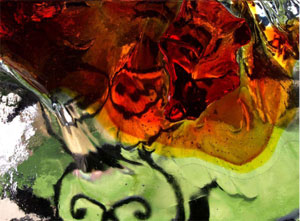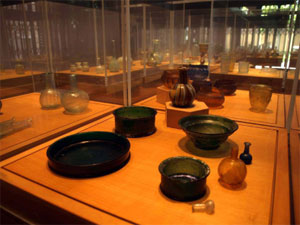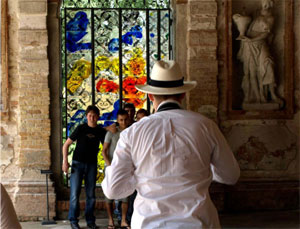
Detail of Gaspari’s stained glass window:...The wateriness, semi-transparency and...colorfulness of Venezia materialized in glass.
Workers are managing to unload large art-type crates from barges at the Giardini in Venezia. The Biennale is still two weeks away so I am heading to the Murano Museum for an exhibit preview in the heat of day, the assumption being apparently that there are better things to do in the islands at more reasonable times. I was hoping that maybe they had figured out in Murano how to manage the intersection of art, design and craft under the marching of globalization. This is an island that for centuries was the biggest producer of glass in Europe, sometimes by using simple techniques like executing craftsmen who switched island allegiances. Napoleon spearheaded the decline of the industry and that of many other strengths of the conquered Serenissima (Venezia’s local name). Glassworks made a comeback in the 1950’s and the dance with kitsch has been scandalous ever since.
The exhibit is a retrospective of Luciano Gaspari’s glass works. A Venetian modernist painter to whom “everything is colour” in the words of one appreciative critic, Gaspari not surprisingly took up glass making. Is there a better way of displaying pigment? Contrary to other modern artists, Gaspari didn’t simply create designs for maestros to produce glass pieces; he immersed himself in the craft of glass making. Gaspari showed his paintings and glass in innumerable Biennales but at a time when curatorial efforts may not have been as encyclopedic as they are today.
(Dottore) Ennio Pouchard, one of the co-curators, graciously gives me the run of the exhibit. Luciano Gaspari had a long productive life until he passed at the age of 94 in 2007. His work speaks of modernism from avant-garde to passé. He was informally associated with the Spatial Movement led by Lucio Fontana. Despite the graciousness of the hosts I fail to see the alchemy of glass, sand to precious goods, transcending the uniform and familiar materiality of glass. Yes, the colors are amazing, but… I have misplaced my high expectations. One is by definition contemporary to her time. And Gaspari did his best at his time, reportedly jotting down on pieces of paper Theodor Adorno’s statement that “Art is magic freed from the lie of being true.” [This quote is from Minima Moralia ca. 1950]. So the man seems to have struggled with the limitations of modernism after all.

View of the installation of archeological glass...objects from the 1st and 2nd centuries at the...Murano Museum.
With everybody scurrying to the (free) lunch, I examine closely the large stained glass window on the ground floor, superb colors, all the wateriness of Venezia solidified in glass. The messy strikes of gold foil and the traces of process seem to speak to our contemporary concerns. Maybe there is hope, keep walking past the elaborated and expected glass works, go up and down and there on the first floor (second floor for Italians) the mid-day sweating pays off: thirty two floating cases with hundreds of archeological glass objects from the 1st and 2nd centuries. The cases feel like the Joseph Beuys vitrines in the Darmstadt collection, but the effort is collective here and not the strike of the artist as a genius. This installation is superbly multiple, engaging, almost participatory, function and process driven, wounded, cracked, and open. An installation that precedes by two millennia and betters the McElheny-Fuller-Noguchi utopian “total reflectivity” exercises it is also an installation that creates a dense space with tiny objects, a spatial and cultural span of two thousand years. It should be in the upcoming Biennale but is most likely to be found in an edition of Documenta. One of the case labels mistranslates from Italian in a serendipitous manner; these are “Grave Goods.”
Jorge Misium is an artist and part-time writer residing in Venezia, he’s at work on an outdoor project for OPEN’09 launching September 3rd in the Giardini and Lido di Venezia.







